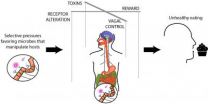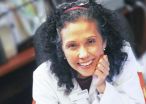(Press-News.org) DETROIT – The Aug. 15 edition of the prestigious journal Science features a major article about the most important problem in obstetrics: preterm labor. The article, "Preterm labor: one syndrome, many causes," delivers a powerful message: preterm birth is not one condition, but many, and provides a framework for meeting this challenge.
"There are 15 million preterm babies born annually, and the condition affects 5 percent to 15 percent of all pregnancies, with the highest rates in North America and Africa. Prematurity is the leading cause of infant death up to age 1and the second-leading cause of childhood death before the age of 5," said Roberto Romero, M.D., D.Med.Sci., chief of the Perinatology Research Branch of the Eunice Kennedy Shriver National Institute of Child Health and Human Development located at Wayne State University and the Detroit Medical Center. "We have made progress by identifying the causes of premature labor, and now we propose that it is possible to reframe the problem and make it tractable."
A common belief is that preterm labor is merely labor that starts too soon. This perception derives from the fact that labor, whether term or preterm, has the same features – increased uterine contractility, opening of the cervix and rupture of the membranes. "However," Dr. Romero said, "the fundamental difference is that normal labor at term occurs when the uterus and placenta cannot continue to support the growth of the fetus within the womb. In contrast, preterm labor results from several disease states."
Dr. Romero considers premature labor a syndrome – a collection of syndromes and signs – caused by multiple disease processes. A typical example of these disease processes is a "silent" intra-amniotic infection. Bacteria normally present in the vagina sometimes ascend into the amniotic cavity, triggering inflammation that in turn initiates premature labor.
From an evolutionary perspective, Dr. Romero explained, the onset of premature labor in the context of infection can be considered to have survival value, because it allows the mother to expel infected tissue (the membranes and fluid) and maintain reproductive fitness for a future pregnancy. This unique mechanism of maternal host defense comes at a price: prematurity.
Physicians and scientists at the PRB are now asking why some women develop a "silent" infection that can cause preterm labor and rupture of membranes, and some do not.
Other patients do not have infection, but have other disease states. For example, some women present with vaginal bleeding and uterine contractions, and they have inadequate blood supply to the placenta. Studies at the PRB, WSU and DMC show that some patients with premature labor have very narrow spiral arteries, which fail to expand and do not provide sufficient blood supply to the placenta. Researchers are investigating biomarkers in maternal blood that can identify these patients.
Another fascinating discovery is that maternal anti-fetal rejection can explain some cases of premature labor. The fetus and placenta express both maternal and paternal antigens, and are therefore allografts (or transplants). The placenta has been considered the most successful transplant in nature. However, sometimes the mother rejects the paternal antigens expressed in the placenta, and this causes preterm labor. New research taking place at WSU, DMC and the PRB is focused on the identification of biomarkers responsible for maternal anti-fetal rejection.
Premature labor can also begin by a decline in progesterone action. Progesterone is essential for the maintenance of pregnancy and keeps the cervix closed until the onset of labor at term. A decline in progesterone action leads to a short cervix, which predisposes to premature labor. The administration of vaginal progesterone to patients with a short cervix can reduce the rate of preterm birth by 45 percent, as well as the rate of respiratory distress syndrome, the most common complication in premature babies. A policy of universal cervical screening is being implemented in Detroit, coupled with the administration of vaginal progesterone.
"Progress in the prevention of premature labor will require deciphering the mechanisms of disease, the identification of specific biomarkers and implementation of therapeutic interventions," Dr. Romero said. "The PRB, Wayne State University and the Detroit Medical Center have created a unique partnership to study the biome of pregnancy and how it is altered in premature labor. This promising initiative will support a new knowledge-based economy in Detroit."
Dr. Romero recognized the exceptional vision of WSU President M. Roy Wilson, the University's Board of Governors, WSU School of Medicine Dean Valerie M. Parisi, M.D., M.P.H., M.B.A.; the leadership of the DMC; and the city of Detroit for "making possible many of the discoveries described on the pages of Science, for much of this work has taken place in Detroit."
INFORMATION:
About Wayne State University School of Medicine
Founded in 1868, the Wayne State University School of Medicine is the largest single-campus medical school in the nation, with more than 1,000 medical students. In addition to undergraduate medical education, the school offers master's degree, doctoral and M.D.-Ph.D. programs in 14 areas of basic science to about 400 students annually.
Connect with us on Facebook, Twitter @wsu_med_school and Pinterest.
About the Detroit Medical Center
The Detroit Medical Center operates DMC Children's Hospital of Michigan with nine specialties centers, DMC Detroit Receiving Hospital, DMC Harper University Hospital, DMC Huron Valley-Sinai Hospital, DMC Hutzel Women's Hospital, DMC Rehabilitation Institute of Michigan with more than 30 outpatient locations, DMC Sinai-Grace Hospital, DMC Surgery Hospital, and DMC Heart Hospital opening in August. Detroit Medical Center is proud to be the official Healthcare Services Provider of the Detroit Tigers, Detroit Red Wings, Detroit Pistons, Detroit Grand Prix and the Detroit Free Press Marathon, with six DMC Sports Medicine clinics and Sports Performance Academy locations.
For more information, visit http://www.dmc.org. "Like" DMC on Facebook at http://www.facebook.com/dmcheals, follow DMC on Twitter at @dmc_heals or visit the DMC YouTube page at http://www.youtube.com/DetroitMedicalCenter.
'Science' features PRB, WSU, DMC advances in preterm birth
2014-08-15
ELSE PRESS RELEASES FROM THIS DATE:
Charges for blood tests vary across California hospitals
2014-08-15
New UC San Francisco research shows significant price differences for ten common blood tests in California hospitals, with some patients charged as little as $10 for one test while others were charged $10,169 for the identical test.
The analysis of charges at more than 150 California hospitals looked at blood tests that are often required of patients, such as lipid panel, basic metabolic panel, and complete blood cell count with differential white cell count.
Hospital ownership and teaching status help explain a portion of the variation – prices generally were lower ...
Do gut bacteria rule our minds?
2014-08-15
It sounds like science fiction, but it seems that bacteria within us — which outnumber our own cells about 100-fold — may very well be affecting both our cravings and moods to get us to eat what they want, and often are driving us toward obesity.
In an article published this week in the journal BioEssays, researchers from UC San Francisco, Arizona State University and University of New Mexico concluded from a review of the recent scientific literature that microbes influence human eating behavior and dietary choices to favor consumption of the particular nutrients they ...
Stroke researchers link ability to self-administer medication with memory loss
2014-08-15
West Orange, NJ. August 15, 2014. Kessler stroke researchers and colleagues have identified an association between over-optimistic estimation of one's own ability to take medications accurately, and memory loss among stroke survivors. Results indicate that assessing patients for their ability to estimate medication skills accurately may predict memory disorder. The article, "Stroke survivors over-estimate their medication self-administration ability (MSA), predicting memory loss," was epublished ahead of print on May 28 by Brain Injury (doi:10.3109/02699052.2014.915984). ...
Visual exposure predicts infants' ability to follow another's gaze
2014-08-15
Following another person's gaze can reveal a wealth of information critical to social interactions and also to safety. Gaze following typically emerges in infancy, and new research looking at preterm infants suggests that it's visual experience, not maturational age, that underlies this critical ability.
The research is published in Psychological Science, a journal of the Association for Psychological Science.
"To the best of our knowledge, this is the first study showing that some aspects of the early development of social cognition is influenced by experience, even ...
NASA satellite spots a weakening Karina, now a tropical storm
2014-08-15
NASA's Terra satellite passed over Hurricane Karina before it weakened to a tropical storm early on August 15 and imagery showed the vertical wind shear was already taking its toll.
NASA's Terra satellite passed over Karina on August 14 at 2:40 p.m. EDT when it was still clinging to hurricane status and noticed that wind shear was already having an effect on the storm's structure. The Moderate Resolution Imaging Spectroradiometer or MODIS instrument captured an image that showed that the bulk of Karina's clouds were being pushed to the western side of the storm. That ...
NASA sees no punch left in Tropical Storm Julio
2014-08-15
Tropical Storm Julio doesn't have any strong thunderstorms or strong convection left in it according to infrared satellite imagery from NASA.
When NASA's Aqua satellite passed over Tropical Storm Julio on August 14 at 12:23 UTC (8:23 a.m. EDT), the Atmospheric Infrared Sounder known as AIRS analyzed the clouds and temperatures of the storm. The AIRS data showed that cloud tops had warmed and dropped lower in the atmosphere. That indicates that the strength behind rising air had weakened and was not forming strong, high thunderstorms with cold cloud tops.
There was a ...
Bigger government makes for more satisfied people, international Baylor study finds
2014-08-15
People living in countries with governments that spend more on social services report being more contented, according to a Baylor University study.
"The effect of state intervention into the economy equals or exceeds marriage or employment status — two traditional predictors of happiness — when it comes to satisfaction," said Patrick Flavin, Ph.D., assistant professor of political science in Baylor's College of Arts & Sciences.
The study — "Assessing the Impact of the Size and Scope of Government on Human Well-Being" — is published in the journal Social Forces. The researchers ...
Dynamic culture of a thermosensitive collagen hydrogel improves tissue-engineered peripheral nerve
2014-08-15
Tissue engineering technologies offer new treatment strategies for the repair of peripheral nerve injury, but cell loss between seeding and adhesion to the scaffold remains inevitable. In a study reported on the Neural Regeneration Research (Vol. 9, No. 14, 2014), a thermosensitive collagen hydrogel remained as a liquid when kept at temperatures below 10°C and gelled when the temperature was increased to 37°C in an incubator for 30 minutes, which was used as an extracellular matrix and combined with bone marrow mesenchymal stem cells to construct tissue-engineered peripheral ...
Incentives, innovation and growth
2014-08-15
Over the past decades, the economic sciences have seen fundamental breakthroughs in our understanding of human responses to incentives in the face of uncertainty and strategic interactions. But what is the scope and what are the limits for applying these models in the design of better institutions and better policies? And to what extent can they teach us what is needed to encourage the innovation that drives economic growth and social wellbeing? These are among the questions to be debated among 17 Nobel Laureates in Economic Sciences and approximately 450 aspiring young ...
New ways to treat solid tumors
2014-08-15
An international team of scientists has shown that an antibody against the protein EphA3, found in the micro-environment of solid cancers, has anti-tumour effects.
As EphA3 is present in normal organs only during embryonic development but is expressed in blood cancers and in solid tumours, this antibody-based approach may be a suitable candidate treatment for solid tumours.
The researchers from Monash University and Ludwig Cancer Research, in Australia, and KaloBios Pharmaceuticals, in the US, have had their findings published in the journal Cancer Research.
The ...




